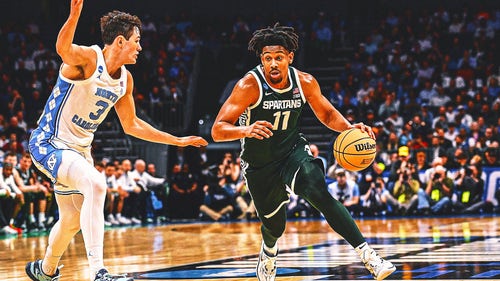Final Four, football, fencing? College athlete salaries will deeply impact future US Olympic hopes
GLENDALE, Ariz. (AP) — At the Final Four this week, they will play for a trophy and the right to cut down the nets. Also at stake: Olympic gold medals.
In one of the increasingly urgent peculiarities of big-time college sports, the financial fates of college basketball players and their football brethren will have an outsized impact on America's ability to field successful Olympic teams beyond this summer's Paris Games.
Every issue consuming college sports right now — NIL, potential player salaries, conference realignment, TV deals, the expansion of the football playoff and maybe the basketball tournament — will affect how crew, gymnastics, wrestling and dozens of other Olympic sports teams do at the Games for years to come.
“Our friends at the USOPC are rightfully concerned,” said Florida athletic director Scott Stricklin, who serves on a U.S. Olympic and Paralympic Committee panel that studies the college-Olympic connection.
Unlike virtually all countries, the United States government does not fund its Olympic teams. For decades, that system has worked because the U.S. has the world's most extensively developed college system, which is where the bulk of the nation's Olympic athletes — and hundreds representing other countries, as well — get their training.
But the teams they play for are reliant on the overall health of football and men's basketball programs, revenue from which pay for virtually all Olympic sports played on campuses across the U.S. Based on recent trends, some 75% of the U.S. team heading to the Paris Olympics later this year will be composed of athletes who came out of the college system; 82% of U.S. Olympic medalists at the Tokyo Games in 2021 played their sport in the NCAA.
In the new landscape of college sports — one in which players get paid through NIL compensation deals, but could also start revenue sharing with the schools themselves — a key question is whether there will be enough money to finance all those payments while also funding the more than 5,900 “small-sport” programs spread across 360 NCAA Division I schools that are the pipeline to the Olympics.
One estimate is that NCAA schools spend more than $5 billion a year on so-called non-revenue, or Olympic, sports.
Whether it’s the recent decision in a case involving Dartmouth players who want to unionize or NCAA President Charlie Baker’s proposal to pay college players $30,000 a year, it seems inevitable that universities will be on the hook for paying athletes at some point in the next decade.
Sarah Hirshland, the CEO of the USOPC, said if that happens, some schools may choose to fund at least a portion of the tab by making cuts in their Olympic sports programs.
“This is where I get super uncomfortable and say, ‘Let’s make sure we are really thoughtful about this,’” Hirshland said. “Providing broad-based sport programs on campus is an essential part of our sport culture in the U.S.”
Some new money might be found through revenue increases from a recently negotiated TV deal with ESPN, worth $7.8 billion over six years, for the College Football Playoff. There is also a chance the $8.8 billion contract for March Madness, good through 2032, could be reopened if the NCAA expands the tournament from 68 teams.
But even leaders at schools that could benefit most from those increased revenues don't think it would be enough to cover payments to players across every athletic program.
Alabama athletic director Greg Byrne estimated player salaries will come with an eight-figure price tag “and those are resources and revenues that don't exist.”
“And so, the impact that could have on the Olympic sports, on the number of sports you are able to offer, the level of it — I've heard colleagues say, ‘Well, we’re just going to scale back what we offer,'” he said.
Not a good idea, says two-time Olympic wrestling champion John Smith, who coaches at Oklahoma State. He addressed the reality that the majority of kids who get involved in sports aren't looking to get rich.
“What’s that going to do with our society?” Smith said. "What’s that going to do to high school, little league, youth sports? How is all that going to be affected? Because it will be affected.”
The mushrooming amounts embedded in NIL deals also will be part of this conversation. Though they don't come directly out of school coffers, they are run by “collectives” with close ties to the schools that are often funded by donors, whose money might be redirected toward the collective rather than the school.
“So, they say, ‘How do you want us to spend it? Do you want us to send it to the athletic department to help pay coaches? Or do you want it to go to student-athletes?’" said Mike Roth, a former athletic director at Gonzaga. "But the total amount of money that people are going to give is probably not going to change significantly.”
Not long ago, with the pandemic straining athletic department budgets, Stanford made the unpopular choice to shut down 11 of its 36 varsity programs. A near revolt ensued, as did a massive fundraising effort, and Stanford backtracked. One stat that stood out back then: Had Stanford athletes been their own country at the 2016 Olympics, they would've placed 11th on the medals table.
These days, some of the same conversations that led Stanford to cut programs are spreading across America's college landscape.
“It's challenging in these times as resources become limited," Stanford athletic director Bernard Muir said. "But we still feel like this place is an athletes village and we want to really grow that. We're proud of the Olympic movement and we want to continue that for quite some time to come.”
___
AP sports writers Janie McCauley and Cliff Brunt contributed to this report.
___
AP Summer Olympics: https://apnews.com/hub/2024-paris-olympic-games







































































































































